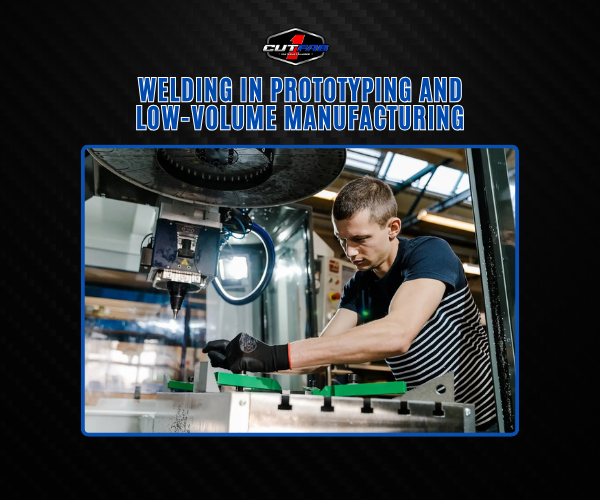
The Role of Welding in Prototyping and Low-Volume Manufacturing!
When it comes to innovation, speed and flexibility are everything. That’s where welding in prototyping and low-volume manufacturing steps in as a game-changer. Unlike high-volume production, this specialized approach empowers engineers and manufacturers to iterate quickly, test efficiently, and bring ideas to life without the massive overhead.
Whether it's a one-off prototype or a small production run, welding delivers unmatched precision and adaptability. In this blog, we’ll explore how welding extends far beyond traditional mass production and why it's essential for creating custom, functional parts at lower volumes—faster and smarter than ever before.
Why Welding is Ideal for Prototypes
When you're developing a prototype, your design needs to evolve—and fast. That’s where welding in prototyping and low-volume manufacturing offers a distinct advantage. Welding creates strong, durable joints that allow engineers to test the structural integrity of parts under real-world conditions. It's not just about holding things together; it’s about validating form, function, and reliability.
But here’s the real win: speed of iteration. Welded prototypes can be quickly modified without having to start from scratch. Need to tweak a bracket or adjust dimensions? Weld it, test it, change it—all within hours, not days.
Unlike processes that rely on long lead times or custom tooling, welding provides the flexibility and responsiveness modern product development demands. From automotive to aerospace, welding empowers innovators to create functional, testable prototypes that move projects forward efficiently and cost-effectively.
That’s why it’s not just ideal—it’s indispensable.
Choosing the Right Weld Type for Prototypes
Not all welds are created equal—especially in welding in prototyping and low-volume manufacturing. Choosing the right weld type can make or break your prototype’s performance, cost, and turnaround time. Let’s break down the big three: MIG, TIG, and Stick welding, and how they fit into small project prototyping.
MIG welding (Metal Inert Gas) is a favorite for fast, clean welds on a variety of metals. It’s ideal for quick assemblies and consistent results, making it a go-to for low-volume runs.
TIG welding (Tungsten Inert Gas) offers unmatched precision and control, which is perfect when your prototype requires tight tolerances and a flawless finish. TIG is slower, but it’s the top choice for intricate, high-performance components—especially in aerospace, medical, or automotive prototyping.
Stick welding, while less common in prototyping, is great for working with thicker materials or outdoor conditions where portability is key.
But don’t forget material compatibility. Stainless steel, aluminum, and mild steel all respond differently to heat and filler material. Choosing the wrong weld type can cause warping, weak joints, or even structural failure during testing.
Bottom line? The weld method you choose in the prototype stage should align with your material, speed, and functional goals. Make the right choice, and you’ll save time, money, and headaches down the road.
Cost Considerations for Low-Volume Weld Projects
When it comes to welding in prototyping and low-volume manufacturing, controlling costs without compromising quality is key. Unlike mass production, low-volume weld projects require a more strategic approach to budgeting—because every hour and every weld counts.
Time and Labor Costs
Time is money—especially in fabrication. Labor often makes up the largest portion of welding costs in low-volume runs. Precision welds like TIG require more setup and execution time, which drives up labor rates. On the other hand, MIG welding can reduce time but may not suit all materials or tolerances.
To keep costs in check, plan your project around weld efficiency. Choose the method that provides the right balance of speed, skill level required, and weld integrity. Also, work with a welder or fabricator who understands the prototype mindset—someone who can adapt quickly and reduce waste.
Common Pitfalls to Avoid
One of the most expensive mistakes? Rework. Poor material selection, incorrect weld types, and lack of design for manufacturability can lead to failed prototypes and costly revisions.
Avoid over-engineering your welds. Keep designs simple and functional. Make sure your materials and welding processes are fully compatible. And always communicate clearly with your welding team to prevent delays or scope creep.
A smart cost strategy isn’t about cutting corners—it’s about cutting inefficiencies while still delivering high-quality, test-ready prototypes.
Conclusion
Welding isn’t just for the factory floor—it's a powerful tool for innovation. In the world of welding in prototyping and low-volume manufacturing, businesses have the flexibility to experiment, iterate, and refine designs with speed and confidence. Whether you’re developing the next big product or optimizing a custom solution, welding allows you to create durable, functional prototypes without committing to full-scale production.
The ability to test, tweak, and improve—without major costs or delays—gives companies a competitive edge. And as markets demand faster time-to-market and higher customization, welding becomes not just a fabrication method but a strategic asset.
So, if you're looking to reduce development time, improve structural testing, and gain full control over your product’s evolution, it’s time to embrace welding in your prototyping process. Start small, think big, and weld your way to better, smarter innovation.
